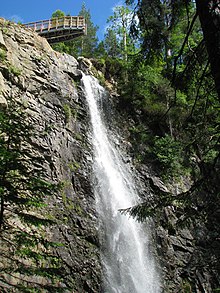
Plodda Falls (Gaelic: Eas Ploda) is a waterfall, situated 5 km south-west of the village of Tomich, near Glen Affric, in the Highlands of Scotland. The falls are 46 m high, and are on the Allt na Bodachan, near where it flows into the Abhainn Deabhag, which in turn joins with the River Affric to form the River Glass.[1][2]
Plodda Falls are a popular tourist attraction. In 1880, a footbridge was built across the top of the falls, by Lord Tweedmouth, who owned the Guisachan estate. In 2005, the Forestry Commission found this bridge to be dangerous, and it was closed. It was replaced by a new viewing platform in 2009.[3][4]
See also
[edit]References
[edit]- ^ Ordnance Survey 1:25,000 scale Explorer map series, sheets 309-470
- ^ "Plodda Falls - Glen Affric". Forestry Commission Scotland. Archived from the original on 16 October 2011. Retrieved 31 March 2011.
- ^ "Footbridge Closure At Plodda Falls, By Glen Affric". Forestry Commission Scotland. 19 December 2005. Archived from the original on 2 April 2010. Retrieved 31 March 2011.
- ^ "Beauty spot bridge to be replaced". Inverness Courier. 10 February 2009. Retrieved 6 April 2011.[permanent dead link]
57°16′20″N 4°51′33″W / 57.27226°N 4.85926°W
Well, that’s interesting to know that Psilotum nudum are known as whisk ferns. Psilotum nudum is the commoner species of the two. While the P. flaccidum is a rare species and is found in the tropical islands. Both the species are usually epiphytic in habit and grow upon tree ferns. These species may also be terrestrial and grow in humus or in the crevices of the rocks.
View the detailed Guide of Psilotum nudum: Detailed Study Of Psilotum Nudum (Whisk Fern), Classification, Anatomy, Reproduction